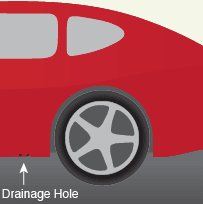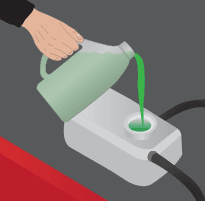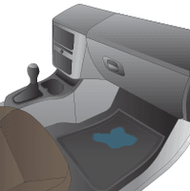How to Detect and Fix AC Leaks In Your Car
9th Feb 2016
- Smell the car.
If your car has been regularly leaking water from the AC unit, it will have likely been dripping onto your car’s floor carpeting. The likely location is on the passenger side of the vehicle. If the car smells like mildew or mold, it’s because the carpet has enough water for mildew to form before the water has dried or evaporated. This is indicative of a fairly extensive leak from the AC unit.
- Touch the floor of your vehicle.
 It’s especially important to do so during a dry day, and after you have had the AC unit running for a little while. If the
carpet is wet, you have an AC unit leakage inside of your cabin. However, it is important to note that wetness on the carpet can come from other sources, some of which will likely require other interventions. If you feel moisture on the floor of your vehicle that is sticky, you’re not dealing with an AC water leakage, but a larger problem with engine coolant leaking into the vehicle. Alternatively, if you find the inside of the windshield carries a film some sweet smelling, slick material, you’re likely dealing with antifreeze leaking from your heater core.
It’s especially important to do so during a dry day, and after you have had the AC unit running for a little while. If the
carpet is wet, you have an AC unit leakage inside of your cabin. However, it is important to note that wetness on the carpet can come from other sources, some of which will likely require other interventions. If you feel moisture on the floor of your vehicle that is sticky, you’re not dealing with an AC water leakage, but a larger problem with engine coolant leaking into the vehicle. Alternatively, if you find the inside of the windshield carries a film some sweet smelling, slick material, you’re likely dealing with antifreeze leaking from your heater core.
If you do feel moisture, but you’re having a hard time determining if your car is leaking coolant or water, you can use a paper towel to figure this out. Simply place a paper towel on the passenger side floor where the leak is occurring. Then, run the system until the leak starts again. If the wet spot on the paper towel takes on a different color, you have a coolant leak from a faulty heater core seal. If it doesn’t change color, you’re dealing with condensate from the AC unit.
-
Look under the car while the AC has been running for a short time.
 Always do so on a relatively warm and dry day. The AC unit on your car helps moderate humidity in the cabin as well as cool down the air. The unit gathers humidity from the air. This excess water gathers inside a reservoir, and is then dripped out of the bottom of the car through a pipe. You have likely seen this before, and maybe have wondered if there was some leakage problem. This is normal and is purely by design to keep the water from getting back inside of the vehicle. If you find that you car is not dripping any water from underneath, even with the AC running on a hot and humid day, you likely have an issue with water leaking inside of your vehicle.
Always do so on a relatively warm and dry day. The AC unit on your car helps moderate humidity in the cabin as well as cool down the air. The unit gathers humidity from the air. This excess water gathers inside a reservoir, and is then dripped out of the bottom of the car through a pipe. You have likely seen this before, and maybe have wondered if there was some leakage problem. This is normal and is purely by design to keep the water from getting back inside of the vehicle. If you find that you car is not dripping any water from underneath, even with the AC running on a hot and humid day, you likely have an issue with water leaking inside of your vehicle.
-
Utilizing a Leak Detection Kit
- Locate the drainage hose underneath your car.
 All you will need is a simple car jack to locate this. The drain hose is generally made of rubber and has an open, downward facing orifice. It’s typically very thin, about the size of a finger. There are several ways to unclog it.
All you will need is a simple car jack to locate this. The drain hose is generally made of rubber and has an open, downward facing orifice. It’s typically very thin, about the size of a finger. There are several ways to unclog it.
- Use a wire coat hanger.
 An unfolded wire coat hanger can be stuck up the tube to jostle out any material that could be clogging the exit. This is a simple method, although it does come with some dangers. You could potentially puncture the tube, which would only result in having to spend money on replacing it. Use this method at your own risk.
An unfolded wire coat hanger can be stuck up the tube to jostle out any material that could be clogging the exit. This is a simple method, although it does come with some dangers. You could potentially puncture the tube, which would only result in having to spend money on replacing it. Use this method at your own risk.
- Use compressed air or even high pressure water to force the clog out.
Using an air gun, pump air into the hose from under the car, ensuring that the hole is closed up as much as possible. A few squirts of high-pressure air should release the clog and allow water to flow right through.
Alternatively, high pressure water can be used for this same purpose. In order to do this, you will want to find a longer hose that can fit overtop of the small exit hose under the car. Stick one end overtop of the exit hose. Use a garden hose to squirt a few bursts of high pressure water. Like the compressed air, this should help loosen the clog, allowing water to flow through once again.
Car designers create vehicles specifically to keep things out of the interior cabin. Unless you’re driving a convertible with the top down, water should never find its way to the inside of your car. Unfortunately, things can go wrong, including water or coolant leaking from your air conditioning unit. The next time you step into your car, you may want to check for an AC water leak. Water leaking inside of your car can come from various sources, but unless you’re actively checking for it, you may even miss that there’s a problem.
Click here to jump into a section:
|
Detecting AC Water Leaks |
Why the AC Leaks Water | Fix a Clogged Drain Hole | Fix Faulty Seals |
How to Detect an AC Water Leak in Your Car
The same way that you would use UV dye for any sort of leak, it can also be used in detecting AC leaks within your car. By injecting a small amount of fluorescent dye to the refrigerant with a syringe, you are able to trace the dye as it follows the refrigerant. If it goes through any holes or cracks, it will then lead you straight to any leaks in the system. To illuminate the dye, an ultraviolet (or UV) light is used, which typically turns the dye into a glowy greenish-yellow or blue. To make the UV dye stand out even more, you can wear a pair of yellow-tinted glasses to improve the visibility by increasing the visual contrast of the dye. This all encompassing leak detection kit by Tracerline has everything you'll need to detect leaks with this method.
Why is my AC Leaking Water?
There are two main reasons why water or coolant may be leaking from your AC unit into your vehicle’s cabin: faulty, leaking seals and clogged drain hoses.
How to Fix a Clogged Drain Hole
Fixing the clogged drain hole is perhaps the easiest fix that anyone can do. There are also preventative measures you can take afterward to help keep it from occurring all over again.
An easy preventative fix involves checking the intake right under the hood. Lift the hood of your car and check the intake. This is the area right by the windshield wipers. Often, the intake gets clogged out with plant material, such as leaves or other plant material. You can clear this out by hand, or you can use a shop vac to suck up the material. Keeping this area of your car clean is a sure way to help prevent future clogs.
How to Fix Faulty Seals
 Fixing an issue with faulty seals requires a bit more effort and resources. The seals in your heater core actually require some moisture in order to work properly. If the AC unit has not run in some time, these seals can become dry and brittle. They will eventually crack, leading to leaks in the system. However, replacing an entire heating core is an expensive process.
Fixing an issue with faulty seals requires a bit more effort and resources. The seals in your heater core actually require some moisture in order to work properly. If the AC unit has not run in some time, these seals can become dry and brittle. They will eventually crack, leading to leaks in the system. However, replacing an entire heating core is an expensive process.
A much simpler fix is to utilize repair kits that can be purchased as most auto shops. These will typically require pouring a fluid into the the radiator tank with the coolant. The fluid will not mix with the coolant, but instead be carried through the system and forming a seal at the point where the leaks occur.
Never ignore an AC leak when you see it occurring. Water damage inside of the vehicle can completely ruin the carpeting. Mold and mildew can cause serious respiratory problems, especially among children. In most cases, your AC unit leak will just be water. The fix is simple, and doing it yourself can save you quite a bit of money. While AC units are designed to not be 100% closed off in order to compensate for build ups, if a clog gets too severe, it can cause hoses and pipes to burst, leading to problems that affect more than just the smell and carpet in your cabin. Preventative measures such as cleaning the intake grate under the hood are the first, best step to stopping most leaks before they start.
Giveaway
JB Tools is giving away two sets of the
Tracerline TP8621 Complete Leak Detection Kit so that you can detect an AC leak in your car before it is too late! Giveaway ends 2/19. Click here to enter: https://www.jbtoolsales.

Sources:
https://www.agcoauto.com/content/news/p2_articleid/...
https://www.youtube.com/watch?v=JvFk-xEoyCk
https://www.denlorstools.com/autoblog/2009/10/ac-wa...
https://www.keepincool.com.au/Have-wet-carpeting-in...
https://community.cartalk.com/discussion/170810/can...


